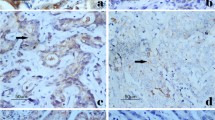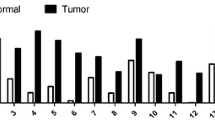Abstract
Aims Annexin A1 (ANXA1) is a calcium- and phospholipid-binding protein that has been implicated in the regulation of inflammation, cell proliferation, and apoptosis. Its role in tumor development and progression is controversial, whereas its role in gastric cancer is unknown. We investigated ANXA1 expression and determined its clinical significance in gastric cancer. Methods and results Tissue microarray blocks containing primary gastric cancer, lymph node metastasis, and adjacent normal mucosa specimens obtained from 1,072 Chinese patients were constructed. Expression of ANXA1 in these specimens was analyzed using immunohistochemistry. Complete loss of ANXA1 expression was observed in 691 (64%) of the 1,072 primary tumors and 146 (86%) of 169 nodal metastases. Loss of ANXA1 expression was significantly associated with advanced T stage, lymph node metastasis, advanced disease stage, and poor histological differentiation. Loss of ANXA1 expression correlated significantly with poor survival rates in both univariate and multivariate analyses. Conclusions ANXA1 expression decreased significantly as gastric cancer progressed and metastasized, suggesting the importance of ANXA1 as a negative biomarker for gastric cancer development and progression.


Similar content being viewed by others
Abbreviations
- ANXA1:
-
Annexin A1
- CI:
-
Confidence interval
- LN:
-
Lymph node
References
Roder DM (2002) The epidemiology of gastric cancer. Gastric Cancer 5(Suppl 1):5–11. doi:10.1007/s10120-002-0203-6
Wang AG, Yoon SY, Oh JH et al (2006) Identification of intrahepatic cholangiocarcinoma related genes by comparison with normal liver tissues using expressed sequence tags. Biochem Biophys Res Commun 345:1022–1032. doi:10.1016/j.bbrc.2006.04.175
Yokota T, Ishiyama S, Saito T et al (2004) Lymph node metastasis as a significant prognostic factor in gastric cancer: a multiple logistic regression analysis. Scand J Gastroenterol 39(4):380–384. doi:10.1080/00365520310008629
Shiraishi N, Inomata M, Osawa N, Yasuda K, Adachi Y, Kitano S (2000) Early and late recurrence after gastrectomy for gastric carcinoma. Univariate and multivariate analyses. Cancer 89(2):255–261. doi:10.1002/1097-0142(20000715)89:2≤255::AID-CNCR8≥3.0.CO;2-N
Gerke V, Moss SE (2002) Annexins: from structure to function. Physiol Rev 82(2):331–371
Iglesias JM, Morgan RO, Jenkins NA, Copeland NG, Gilbert DJ, Fernandez MP (2002) Comparative genetics and evolution of annexin A13 as the founder gene of vertebrate annexins. Mol Biol Evol 19(5):608–618
Morgan RO, Jenkins NA, Gilbert DJ et al (1999) Novel human and mouse annexin A10 are linked to the genome duplications during early chordate evolution. Genomics 60(1):40–49. doi:10.1006/geno.1999.5895
Ross DT, Scherf U, Eisen MB et al (2000) Systematic variation in gene expression patterns in human cancer cell lines. Nat Genet 24(3):227–235. doi:10.1038/73432
Guan-Zhen Y, Ying C, Can-Rong N, Guo-Dong W, Jian-Xin Q, Jie-Jun W (2007) Reduced protein expression of metastasis-related genes (nm23, KISS1, KAI1 and p53) in lymph node and liver metastases of gastric cancer. Int J Exp Pathol 88(3):175–183. doi:10.1111/j.1365-2613.2006.00510.x
Hippo Y, Yashiro M, Ishii M et al (2001) Differential gene expression profiles of scirrhous gastric cancer cells with high metastatic potential to peritoneum or lymph nodes. Cancer Res 61(3):889–895
Wu W, Tang X, Hu W, Lotan R, Hong WK, Mao L (2002) Identification and validation of metastasis-associated proteins in head and neck cancer cell lines by two-dimensional electrophoresis and mass spectrometry. Clin Exp Metastasis 19(4):319–326. doi:10.1023/A:1015515119300
Lim LH, Pervaiz S (2007) Annexin 1: the new face of an old molecule. FASEB J 21(4):968–975. doi:10.1096/fj.06-7464rev
Buckingham JC, John CD, Solito E et al (2006) Annexin 1, glucocorticoids, and the neuroendocrine-immune interface. Ann N Y Acad Sci 1088:396–409. doi:10.1196/annals.1366.002
Bai XF, Ni XG, Zhao P et al (2004) Overexpression of annexin 1 in pancreatic cancer and its clinical significance. World J Gastroenterol 10(10):1466–1470
Ahn SH, Sawada H, Ro JY, Nicolson GL (1997) Differential expression of annexin I in human mammary ductal epithelial cells in normal and benign and malignant breast tissues. Clin Exp Metastasis 15(2):151–156. doi:10.1023/A:1018452810915
Masaki T, Tokuda M, Ohnishi M et al (1996) Enhanced expression of the protein kinase substrate annexin in human hepatocellular carcinoma. Hepatology 24(1):72–81
Johnson MD, Kamso-Pratt J, Pepinsky RB, Whetsell WO Jr (1989) Lipocortin-1 immunoreactivity in central and peripheral nervous system glial tumors. Hum Pathol 20(8):772–776. doi:10.1016/0046-8177(89)90071-3
Wang KL, Wu TT, Resetkova E et al (2006) Expression of annexin A1 in esophageal and esophagogastric junction adenocarcinomas: association with poor outcome. Clin Cancer Res 12(15):4598–4604. doi:10.1158/1078-0432.CCR-06-0483
Paweletz CP, Ornstein DK, Roth MJ et al (2000) Loss of annexin 1 correlates with early onset of tumorigenesis in esophageal and prostate carcinoma. Cancer Res 60(22):6293–6297
Petrella A, Festa M, Ercolino SF et al (2006) Annexin-1 downregulation in thyroid cancer correlates to the degree of tumor differentiation. Cancer Biol Ther 5(6):643–647
Rodrigo JP, Garcia-Pedrero JM, Fernandez MP, Morgan RO, Suarez C, Herrero A (2005) Annexin A1 expression in nasopharyngeal carcinoma correlates with squamous differentiation. Am J Rhinol 19(5):483–487
Shen D, Chang HR, Chen Z et al (2005) Loss of annexin A1 expression in human breast cancer detected by multiple high-throughput analyses. Biochem Biophys Res Commun 326(1):218–227. doi:10.1016/j.bbrc.2004.10.214
Shen D, Nooraie F, Elshimali Y et al (2006) Decreased expression of annexin A1 is correlated with breast cancer development and progression as determined by a tissue microarray analysis. Hum Pathol 37(12):1583–1591. doi:10.1016/j.humpath.2006.06.001
Takes RP, Baatenburg de Jong RJ, Wijffels K et al (2001) Expression of genetic markers in lymph node metastases compared with their primary tumours in head and neck cancer. J Pathol 194(3):298–302. doi:10.1002/1096-9896(200107)194:3≤298::AID-PATH900≥3.0.CO;2-Q
Garcia Pedrero JM, Fernandez MP, Morgan RO et al (2004) Annexin A1 down-regulation in head and neck cancer is associated with epithelial differentiation status. Am J Pathol 164(1):73–79
Saito H, Osaki T, Murakami D et al (2006) Effect of age on prognosis in patients with gastric cancer. ANZ J Surg 76(6):458–461. doi:10.1111/j.1445-2197.2006.03756.x
Zhan YQ, Sun XW, Li W et al (2005) [Multivariate prognostic analysis in gastric carcinoma patients after radical operation]. Ai Zheng 24(5):596–599
Orsenigo E, Carlucci M, Braga M et al (2005) [Prognostic factors of gastric neoplasms: experience with 1, 074 cases undergoing surgical treatment at a single center]. Suppl Tumori 4(3):S86–S87
Wu CW, Hsieh MC, Lo SS et al (1997) Prognostic indicators for survival after curative resection for patients with carcinoma of the stomach. Dig Dis Sci 42(6):1265–1269. doi:10.1023/A:1018814426278
Yokota T, Ishiyama S, Saito T et al (2002) Is tumor size a prognostic indicator for gastric carcinoma? Anticancer Res 22(6B):3673–3677
Yao JC, Tseng JF, Worah S et al (2005) Clinicopathologic behavior of gastric adenocarcinoma in Hispanic patients: analysis of a single institution’s experience over 15 years. J Clin Oncol 23(13):3094–3103. doi:10.1200/JCO.2005.08.987
Hsiang CH, Tunoda T, Whang YE, Tyson DR, Ornstein DK (2006) The impact of altered annexin I protein levels on apoptosis and signal transduction pathways in prostate cancer cells. Prostate 66(13):1413–1424. doi:10.1002/pros.20457
Acknowledgement
We thank Don Norwood for editorial comments.
Author information
Authors and Affiliations
Corresponding author
Rights and permissions
About this article
Cite this article
Yu, G., Wang, J., Chen, Y. et al. Tissue microarray analysis reveals strong clinical evidence for a close association between loss of annexin A1 expression and nodal metastasis in gastric cancer. Clin Exp Metastasis 25, 695–702 (2008). https://doi.org/10.1007/s10585-008-9178-y
Received:
Accepted:
Published:
Issue Date:
DOI: https://doi.org/10.1007/s10585-008-9178-y




